Third in a Series: Preserving the Past to Serve the Future
| Scooped by Global Aqua Link |
For centuries before and after the European colonization of the Mid-Atlantic region of North America, fishing and shell fishing, using traditional methods fed the people of our Bio-region. There are still remnants of that hook and line, passive fishing gear, clamming and oystering, pound nets, dory and net surf fishing, and small trawler fisheries throughout the region, however those fisheries have been diminished as a result of pollution and over fishing.
As the regional waterways become cleaner, mainly as a result of the Federal and State laws and regulations like the Clean Water Act , the Resource Conservation Recovery Act, and “Super Fund” or CERCLA (enforced in part by Waterkeepers and other organizations 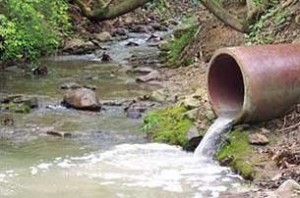 like the Natural Resources Defense Council), sewage discharges, contaminated sediments, and “combined sewer overflows” are being addressed, starting to make our local waterways “fishable” again. It is imperative as we transition to a “post carbon” future that those discharges be reduced and eliminated, so that the fisheries will begin to recover and these traditional and artisanal fisheries will once again be a resource for feeding the Bioregion.
like the Natural Resources Defense Council), sewage discharges, contaminated sediments, and “combined sewer overflows” are being addressed, starting to make our local waterways “fishable” again. It is imperative as we transition to a “post carbon” future that those discharges be reduced and eliminated, so that the fisheries will begin to recover and these traditional and artisanal fisheries will once again be a resource for feeding the Bioregion.
Factory Fishing
Unfortunately unsustainable “factory” fishing,” like factory farming is the norm rather than 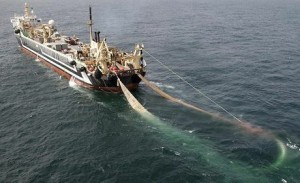 the exception. The global fishing fleet is 2-3 times larger than what the oceans can sustainably support. In other words, people are taking far more fish out of the ocean than can be replaced by those remaining. As a result:
the exception. The global fishing fleet is 2-3 times larger than what the oceans can sustainably support. In other words, people are taking far more fish out of the ocean than can be replaced by those remaining. As a result:
- 53% of the world’s fisheries are fully exploited, and 32% are overexploited, depleted, or recovering from depletion1
- Most of the top ten marine fisheries, accounting for about 30% of all capture fisheries production, are fully exploited or overexploited1
- Several important commercial fish populations have declined to the point where their survival is threatened
- Unless the current situation improves, stocks of all species currently fished for food are predicted to collapse by 2048.
In the US, fishing is being consolidated under corporate control…..companies such as American Seafoods, Trident Seafoods, and True World Foods (owned by the Unification Church) have transformed fishing into a “global extraction industry. They have made fishing “not about a way of life,” or about feeding people and providing economic sustenance for local coastal fishing communities, but rather about “making a good rate of return on their global investment capital. However not all the news is bad.
Tools for a Post Carbon Regional and Durable Fishery
Standing on the banks of the Passaic River with Robert Kennedy Jr. on a blustery fall day in the late 1990’s, we talked about how pollution has robbed families of a valuable right – to enjoy a day of fishing and eating their catch from the waterway nearest their home. The same could be said about traditional commercial fishing on the Hudson and other water bodies in the Mid-Atlantic Bioregion where the present generation of fishing families cannot fish where – and – how the generations that preceded them could. Retaining “know how” over the gap of time it will take for the water to be clean enough and the fish plentiful enough to revitalize this traditional knowledge base will be the work of Transition.
”Today, traditional knowledge is in danger and its disappearance would not only cause the loss of people’s capability to keep and pass on the artistic and natural heritage, but also of an extraordinary source of knowledge and cultural diversity from which the appropriate innovation solutions can be derived today and in the future.”
Community Supported Fisheries, Helping Fishermen Fish Smarter, Not Harder:
There are places where traditional fishing is still practiced, and fishermen have the knowledge to pass on. From Maine to the Carolinas, fishermen and the communities in which they live are starting to “take back” the management of their fisheries. Commercial fishermen long thought of as “ocean rapers” and “bottom scrapers” are at the heart of a “community based fisheries management and science movement, and community supported fisheries.
With the constant changes in the life of fishermen, one place where they can begin to take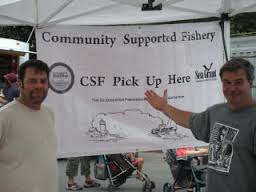 back some control is their relationship with those who eat their catch, the price they get paid for their day’s work and the food systems into which their catch enters.
back some control is their relationship with those who eat their catch, the price they get paid for their day’s work and the food systems into which their catch enters.
It makes no sense any more to pay fishermen a price that doesn’t cover their real cost of operation while the consumers are paying much more than they should for packaged, frozen or days-old seafood trucked hundreds or thousands of miles when it was caught steps away from our homes.
In addition to getting fishermen a better price for their catch, Community Supported Fisheries allow fishermen to have a conversation with seafood consumers about the entire food-supply-chain process of what swims in the ocean to what lands on our plates.
“By creating transparency around our seafood production processes, CSFs help define the importance of local food sources by emphasizing sustainable fishery practices; encouraging environmental sensitivity among fishermen; ensuring higher quality processing standards; providing a direct-to-consumer, low-carbon foot-print; and ultimately, a competitively-priced, higher quality seafood experience for the consumer.”
Community-Based Fisheries Management
Who knows better how to manage the fisheries of the commons? Should it be some agency from far away or the fishermen, their communities, and the scientists working with them to develop a sustainable fishery?
Mounting pressure on marine fisheries, in the Mid-Atlantic and worldwide, calls for concerted action by coastal communities and local fishermen that have for generations played a vital stewardship role. “The goal of community-based fisheries management, is to act on current market- and policy-driven opportunities to establish a community-based, self-supporting model for achieving healthy fisheries and fishing economies.”
Community and Regional Fishing Associations (CFAs and RFAs), as provided through the 2007 Magnuson-Stevens Fishery Conservation and Management Act, (MSA, section 303A) present opportunities for reasserting the role of fishing communities in the pursuit of economic, social and environmental success through the implementation of catch share programs that foster resource and community sustainability. CFAs/RFAs can effectively act as Trusts, holding limited access privileges (catch shares) to anchor access to fish in a community, and could lease catch quota or other access privileges to individual fishermen.
Participant Organizations in the Mid-Atlantic and New England include but are not limited to the following:
- Island Institute, Maine
- Port Clyde Fresh Catch, Maine
- Cape Cod Fisheries Trust, Massachusetts
- Penobscot East Resource Center https://www.penobscoteast.org/, Maine
The Goals of each of these organizations is:
- To deliver programs and services that local fishermen need now to succeed and adapt to changing fisheries.
- To educate and support the next generation of fishermen, managers and scientists using new tools and approaches.
- To establish a pilot program fisheries are co-managed on an ecosystem basis by a collaboration of federal and state government, scientists and local fishermen.
- To contribute to local, national and global learning for sustainable fisheries.
Slow Tech Fishing Practices
Starting with European colonization, fishermen in the Mid-Atlantic found a cornucopia of fish and shell fish in the waters of the Mid-Atlantic. Species that were and in many cases continue to be present in the waters include Shad, Atlantic Herring, Spot, Tautog (Blackfish), Atlantic Sturgeon, Bluefish, Mackerel, Flounder, Fluke, Menhaden (Bunker), Porgy, Tommy Cod, Weakfish, Whitefish, Cod, Ling, Skate, and a variety of Shark. Lobster, Blue claw crab, striped bass , clam, oysters, and a host of other marine species are found in the Bays, Sounds and Rivers.
Small Boat Commercial Fishing:
Traditional and artisanal fishing is making a comeback in the Mid-Atlantic. The Cape Cod Commercial Fishermens Alliance is one example. Many think of commercial fishing in the region as large ocean trawlers and draggers owned by corporate conglomerates that dominate the fishery.
Cape Cod’s smaller-scale fishing tradition is vibrant, sustainable and a model for other  fishing communities. The Alliance believes that community ownership and management of fishing quotas are essential for the fishery and fishing families to thrive.
fishing communities. The Alliance believes that community ownership and management of fishing quotas are essential for the fishery and fishing families to thrive.
The Alliance collaborates with the Community Development Partnership to deliver economic development initiatives to support the fleet, promote good business practices, and support the Cape’s next generation of fishermen.
“The Cape Cod Fisheries Trust helps me build a more profitable business. I lease 20 percent of the scallops I catch from the Trust. It offers me affordable rates that are about half of what I would pay on the open market…. If I could find any scallops on the open market. Yet while access to the quota is huge, what the Trust offers in big picture thinking is even more important. The Trust is good for our local fishermen and good for our economy.” TyeVecchione Scallop Fisherman, Chatham, MA
Net and Dory Fishing in Eastern Long Island:
The traditional fisheries of Eastern Long Island is scallops in the Bays and a surf dory and net fishery for striped bass off the beaches on the ocean side. For generations fishermen launched oar powered and later motorized dories from the beach, surrounded the fish with a net, and hand pulled the net to shore.
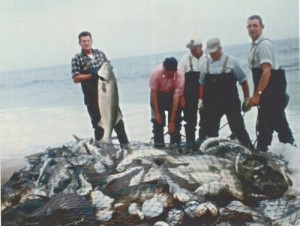 Peter Mathiessen wrote an astounding book about the fishery, the culture and the way of life of the Baymen of Eastern Long Island called Men’s Lives. The title is taken from Sir Walter Scott, “It’s no fish ye’re buying, it’s men’s lives. Men’s Lives is an eloquent portrayal of a disappearing way of life of the Long Island fishermen whose voices—“humorous, bitter and bewildered–are as clear as the threatened beauty of their once quiet shore.”
Peter Mathiessen wrote an astounding book about the fishery, the culture and the way of life of the Baymen of Eastern Long Island called Men’s Lives. The title is taken from Sir Walter Scott, “It’s no fish ye’re buying, it’s men’s lives. Men’s Lives is an eloquent portrayal of a disappearing way of life of the Long Island fishermen whose voices—“humorous, bitter and bewildered–are as clear as the threatened beauty of their once quiet shore.”
”Men’s Lives” becomes a heartbreakingly precise analysis of what is going on outside my own porthole. The highest compliment I can pay to his remarkable book is to acknowledge, not without some writerly grudges, that Mr. Matthiessen understands the man in the woolly hat whom I am now squinting at through the glass far more intimately than I ever can myself.”
As the shoreline of the Hampton’s and Montauk become more gentrified and people object to the noise and smell of this traditional fishery it is almost completely gone. It is important to make sure that this traditional fishery is archived and the skills passed on to a post carbon generation.
Pound Net Fishing in New Jersey:
Fishermen from Belford, a small fishing port on the Bayshore of Raritan Bay in New Jersey rake for clams, do near shore trawling in small vessels, and still set pound nets. The few pound nets left in the Bay are a remnant of this passive fishing technique that 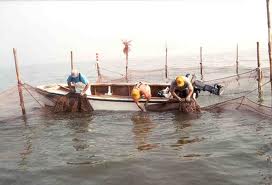 once was ubiquitous along most of NY and NJ’s bays and ocean coasts. The nets are strung between stakes driven into the sand of the shallows taking advantage of a fish’s evolutionary decision to swim away from shore when faced with an obstacle. The fish are led along the net into a pouch from which there is no escape. At each low tide the fish are removed from the net and undersized or fish that cannot be harvested are set free. This method of fishing goes back to pre-European colonization.
once was ubiquitous along most of NY and NJ’s bays and ocean coasts. The nets are strung between stakes driven into the sand of the shallows taking advantage of a fish’s evolutionary decision to swim away from shore when faced with an obstacle. The fish are led along the net into a pouch from which there is no escape. At each low tide the fish are removed from the net and undersized or fish that cannot be harvested are set free. This method of fishing goes back to pre-European colonization.
The modern age of fishing in Belford dawned after the Civil War, when the pound net was introduced to Raritan Bay. These 100-foot-long, multi-chambered nets set onto the bottom of the bay transformed fishing from a livelihood into an industry. Belford was the principal fin-fishing port in the bay. At least 350 fishermen worked the port. Today, there are less than 75.
Once the most prolific commercial port in the inner New York Harbor, Belford is now the only port left in what has become one of the most populated, industrialized and overdeveloped harbors in the world.
Hand Clamming and Oystering in the Mid-Atlantic:
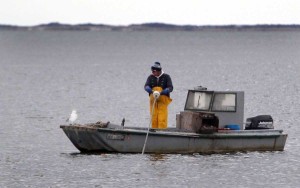 Raking for hard clams from small boats is still the predominant fishery on Raritan Bay in New York and New Jersey. On days where there is a little wind and little tidal current, the Baymen raise small blue tarp sails to cover more ground. Financiers on their way to New York City by ferry are often surprised, if they look up from their Wall Street Journal’s long enough, to see these Baymen rise up out of the early morning fog.
Raking for hard clams from small boats is still the predominant fishery on Raritan Bay in New York and New Jersey. On days where there is a little wind and little tidal current, the Baymen raise small blue tarp sails to cover more ground. Financiers on their way to New York City by ferry are often surprised, if they look up from their Wall Street Journal’s long enough, to see these Baymen rise up out of the early morning fog.
The proximityof this fishery to the huge market of New York City has made it an important economic force for the region. Most of the clamming in local waters requires “depuration” because of bacterial contamination. Raitan Bay is one of the most prolific clam fisheries in New York and New Jersey and those clams have recently been featured in upscale supermarkets like Whole Foods.
There is an active oyster fishery in Long Island Sound and Delaware Bay, and organizations like NY/NJ Baykeeper, The Harbor School , The Hudson River Foundation 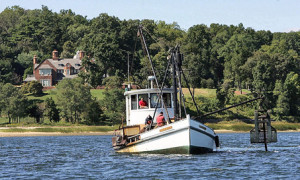 , the River Project , and government agencies like the Army Corps of Engineers are actively restoring oyster beds in the New York/New Jersey Harbor Estuary.
, the River Project , and government agencies like the Army Corps of Engineers are actively restoring oyster beds in the New York/New Jersey Harbor Estuary.
American Shad Fishing on the Hudson River:
“For all practical purposes, the American shad fishery is the last fishery that connects fishermen the length of the river to a tradition that goes back to the Dutch watching the American Indians,” said John Cronin of Cold Spring, a one-time shad fisherman and executive director of the Beacon Institute for Rivers and Estuaries.
The Hudson River is the only river on the east coast of the United States that retains almost every fish species that existed at the time of European colonization. The demise of commercial fishing on the Hudson River began in 1976 when PCBs, or polychlorinated biphenyls, were discovered in striped bass, eels and other fish.
The American Shad, with its delicate flavor and history of abundance, has played a long 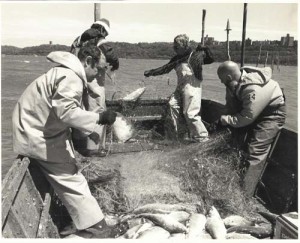 and crucial role on the Hudson valley’s economy. As a natural resource with much potential, fishermen have caught shad as a means of subsistence and , commercially.
and crucial role on the Hudson valley’s economy. As a natural resource with much potential, fishermen have caught shad as a means of subsistence and , commercially.
The Hudson River provides a spawning habitat for shad, and the fishing season begins each spring as the shad leave the Atlantic Ocean and return to the Hudson, making the Hudson River crucial to the fishery. However, throughout the past century the Shad population has been inconsistent, and as recent numbers hit an all-time low it has forced New York State to develop a radical policy in their efforts to restore the once thriving fishery.
The technology to catch shad is quite simple: two poles are pushed into the ground, holding up a net. The tide of the river will push fish into the net, where they will get caught. Fishermen must then manually remove each fish from the net, a labor intensive procedure that requires round the clock work. Because the technology is rather simple and inexpensive, motivated workers had the opportunity to make a living through shad fishing, regardless of their financial circumstances.
Shad were once the Hudson’s most commercially important fishery. It is likely that Native Americans and early European settlers of the Hudson Valley both fished shad, eating them and using them as a source of fertilizer for agriculture.
In 2010, New York Department of Conservation decided to close the commercial and sport fishery, with the long term goal of allowing the river to reestablish the abundance of shad similar to what had been enjoyed in the 1940s Although the fishery had been dissolving for some time, the closure finally ended a long and rich tradition.
General Electric is paying for the cleanup of PCB’s as a result of an order from the USEPA. So, hopefully, with water and sediment quality improvements, the shutdown of the Indian Point nuclear power plant, and better community based management and science, shad fishing on the Hudson will become once again become an artisanal fishery that will feed the people of the Hudson Valley.
Eel Fishing on the Delaware:
American eels are catadromous rather than anadromous fish meaning they migrate to the ocean to mate rather than the other way around like shad or herring. Eels have been a delicacy and an artisanal fishing in the rivers of the North Atlantic.
The Delaware River eel fishery is emblematic of artisan fishing. Each year when the eels 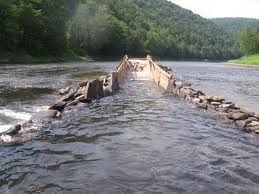 are leaving their fresh water habitat for the Sargasso Sea fishermen build arrow head shaped weirs of river rocks. The eels are drawn to the apex and into a trap. This method of fishing has been going on since before Europeans arrived in North America in the shallow rocky parts of most rivers in the Mid-Atlantic.
are leaving their fresh water habitat for the Sargasso Sea fishermen build arrow head shaped weirs of river rocks. The eels are drawn to the apex and into a trap. This method of fishing has been going on since before Europeans arrived in North America in the shallow rocky parts of most rivers in the Mid-Atlantic.
Elvers, the tiny worm like eels returning from the sea are the subject of an unsustainable intercept fishery . Elvers are so valuable, up to $2600 per pound in 2012, that some unscrupulous fishermen are stretching nets 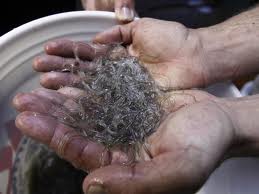 across entire streams. The elvers or glass eels are a delicacy in Japan.
across entire streams. The elvers or glass eels are a delicacy in Japan.
Preserving heritage fishing techniques to serve the future:
There are other sustainable and artisanal fishing like lobstering in the Mid-Atlantic region, but the ones described above are done with simple tools, small boats, and lots of hard work. With cleaner water, restored habitat, restraint on the part of the fishing community, and willingness on the part of experience fishermen to share their knowledge — it is possible that artisanal and sustainable fishing using heritage techniques will become part of Transition in a post carbon Mid-Atlantic.
Community Supported Fisheries
Local Catch, Community Supported Fisheries
Salt Sea CFA Gallaway Township NJ
Thimble Island Oyster Company CT
Big City Fish Share Union Market NYC
Local Catch Wakefield RI
Ocean State Fresh, Wakefield RI
The Local Catch Providence RI
Cape Cod Community Supported Fishery MA
South Shore Fish Exchange Scituate, MA
New Hampshire Community Seafood NH
Salt and Sea CSF Kittery ME
Fishery Cooperatives
Cape Cod Commercial Fishermen’s Alliance
An oldie, but maybe still a goodie, fishing cooperatives in the United States
Fisheries Apprenticeships
Knowing more

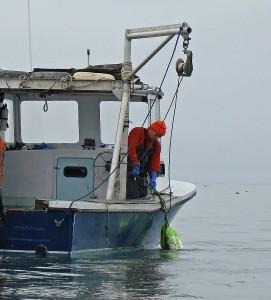
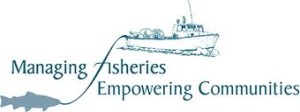

Thank you Andrew
It is a brilliant idea that the clean water act was thought of. It would give us a way to ensure that the future generation will still have an ocean to fish from. And also, many issues are being addressed, such as the sewage discharges, contaminated sediments, and the likes. This way, our ocean will be protected from harm.